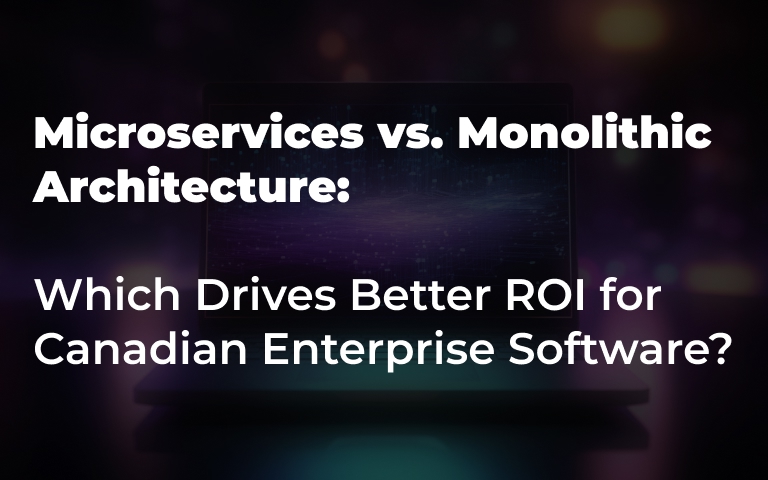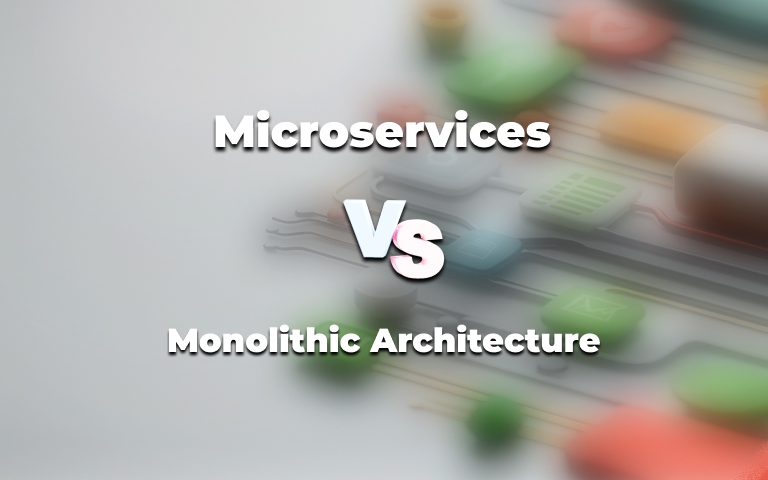In today’s rapidly evolving tech landscape, businesses across Canada are constantly looking for ways to improve their software systems. Enterprise software development in Canada is shifting towards more flexible and scalable solutions. One of the biggest decisions companies face is whether to adopt a microservices architecture or stick with a traditional monolithic approach. Understanding the differences between these architectures and their impact on software architecture ROI can help businesses make informed choices. A well-structured software development strategy in Canada can determine long-term success, and partnering with a web development agency can further enhance software systems’ scalability and efficiency.

Understanding Monolithic Architecture
For years, businesses relied on monolithic architectures to build their software applications. A monolithic structure means that all functionalities of the application exist within a single, unified codebase. Everything, from the user interface to the database management system, is tightly integrated within the software systems.
While monolithic applications are easier to develop and deploy initially, they come with several challenges as the business grows. Scaling a monolithic application often requires increasing infrastructure resources, which can be expensive. Moreover, even a small update can require redeploying the entire application, making the process time-consuming and prone to errors.
The Rise of Microservices Architecture
Microservices architecture, on the other hand, breaks down an application into smaller, independent services that communicate with each other. Each microservice operates as a standalone module responsible for a specific function, such as authentication, payment processing, or user management. This architecture is gaining traction in enterprise software development across Canada due to its flexibility and efficiency.
With microservices, businesses can scale specific components rather than the entire application. This targeted approach to scaling not only saves costs but also improves performance. Software development in Canada has seen an increasing number of startups and established enterprises shifting to microservices for its ability to enhance agility and maintainability.
ROI Comparison: Microservices vs. Monolithic
When considering the ROI of software architecture, several factors come into play, including development costs, scalability, maintenance, and adaptability to market trends.
- Development and Maintenance Costs
Monolithic applications often have lower initial development costs because they require fewer resources and a simpler deployment process. However, as the application grows, maintenance becomes increasingly complex. Businesses that choose a web development agency to manage a monolithic system may face higher long-term costs due to difficulty in updating and scaling.Microservices, on the other hand, may have higher initial development costs since each service requires independent deployment, testing, and monitoring. However, because microservices allow for continuous integration and deployment, they reduce long-term maintenance expenses. - Scalability and Performance
Scaling a monolithic application can be costly because it involves increasing resources for the entire system. In contrast, microservices enable businesses to scale only the necessary components, improving resource efficiency and cost-effectiveness. This is particularly beneficial for Canada’s digital marketing companies and startups, which often experience fluctuating traffic and demand. - Adaptability and Future-Proofing
The technology landscape changes rapidly, and businesses must adapt to stay competitive. AI for web development is becoming more prevalent, and microservices make it easier to integrate AI-driven features into applications. With a modular structure, businesses can upgrade specific services without overhauling the entire system. This adaptability provides a strong ROI advantage for companies looking to stay ahead in software development in Canada.
The Role of Digital Marketing in Software Success
Beyond development, businesses also need to consider how they market their software. Canada’s digital marketing companies emphasize SEO, social media marketing, and PPC advertising to increase visibility. Whether a business chooses monolithic or microservices architecture, strong digital marketing strategies ensure the software reaches the right audience.
SEO services in Canada play a crucial role in promoting new software solutions. Optimized content, targeted email marketing in Canada, and PPC campaigns can generate leads and drive conversions. Software architecture ROI isn’t just about the technical structure—it’s also about how well the product is marketed to its audience.

Choosing the Right Architecture for Your Business
For startups and small businesses, a monolithic approach may be suitable due to its simplicity and lower initial costs. However, as companies scale, they may face limitations that hinder growth. Enterprises looking to maximize efficiency and ROI should consider microservices for their ability to streamline development, enhance performance, and adapt to market demands.
Canada’s enterprises’ digital marketing efforts can also benefit from software built on a microservices foundation. With the ability to quickly adapt to user feedback and industry changes, businesses can stay competitive and maintain a strong digital presence.
Conclusion
Deciding between monolithic and microservices architecture depends on your business goals, budget, and growth plans. While monolithic applications provide a straightforward approach to development, microservices offer scalability, flexibility, and long-term cost savings. As Canada’s software landscape continues to evolve, businesses that invest in the right architecture will see better ROI and a stronger competitive edge in the market.

